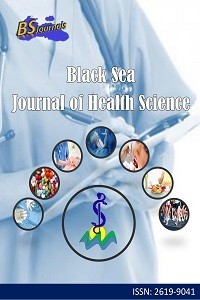Potentially Inappropriate Medications In Geriatric Hemodialysis Patients
Aging, Hemodialysis, Polypharmacy, Inappropriate prescriptions, Potentially Inappropriate medications
Potentially Inappropriate Medications In Geriatric Hemodialysis Patients
Aging, Hemodialysis, Polypharmacy, Inappropriate prescriptions, Potentially Inappropriate medications,
___
- Battistella M, Jandoc R, Ng JY, McArthur E, Garg AX. 2018. A province-wide, cross-sectional study of demographics and medication use of patients in hemodialysis units across ontario. Canadian J Kidney Health Disease, 5: 1-10.
- Beers Criteria® Update Expert Panel. 2019. Potentially inappropriate medication use in older adults. J American Geriat Soc, 67(4): 674-694.
- Chahine B. 2020. Potentially inappropriate medications prescribing to elderly patients with advanced chronic kidney by using 2019 American Geriatrics Society Beers Criteria. Health Sci Rep, 3(4): e214.
- Charlson ME, Pompei P, Ales KL, MacKenzie CR. 1987. A new method of classifying prognostic comorbidity in longitudinal studies: development and validation. J Chronic Dis, 40(5): 373-383.
- Eyigör S, Kutsal Gökçe Y. 2012. Polypharmacy in the elderly: To prescribe or not prescribe “That is the Question”. Turkish J Geriat, 15(4): 445-454.
- Hajjar ER, Hanlon JT, Sloane RJ, Lindblad CI, Pieper CF, Ruby CM, Branch LC, Schmader KE. 2005. Unnecessary drug use in frail older people at hospital discharge. J Am Geriatr Soc, 53(9): 1518-1523.
- Helldén A, Bergman U, von Euler M, Hentschke M, Odar-Cederlöf I, Ohlén G. 2009. Adverse drug reactions and impaired renal function in elderly patients admitted to the emergency department: a retrospective study. Drugs Aging, 26(7): 595-606.
- Ilotto A, Franceschi M, Leandro G, Di Mario F. 2003. Geriatric gastroenterology study group (societè italiana gerontologie geriatria). NSAID and aspirin use by the elderly in general practice: effect on gastrointestinal symptoms and therapies. Drugs Aging, 20(9): 701-710.
- Jones SA, Bhandari S. 2013. The prevalence of potentially inappropriate medication prescribing in elderly patients with chronic kidney disease. Postgrad Med J, 89(1051): 247-250.
- Kaiser MJ, Bauer JM, Ramsch C, Uter W, Guigoz Y, Cederholm T, Thomas DR, Anthony P, Charlton KE, Maggio M, Tsai AC, Grathwohl D, Vellas B, Sieber CC, MNA-International Group. 2009. Validation of the mini nutritional assessment short-form (MNA-SF): a practical tool for identification of nutritional status. J Nutrit Health Aging, 13(9): 782-788.
- Kondo N, Nakamura F, Yamazaki S, Yamamoto Y, Akizawa T, Akiba T, Saito A, Kurokawa K, Fukuhara S. 2015. Prescription of potentially inappropriate medications to elderly hemodialysis patients: prevalence and predictors. Nephrol Dial Transplant, 30(3): 498-505.
- Maes ML, Fixen DR, Linnebur SA. 2017 Adverse effects of proton-pump inhibitor use in older adults: a review of the evidence. Ther Adv Drug Saf, 8(9): 273-297.
- Mahoney FI, Barthel DW. 1965. Functional evaluation: The Barthel Index. Md State Med J, 14: 61-65.
- Manley HJ, McClaran ML, Overbay DK, Wright MA, Reid GM, Bender WL, Neufeld TK, Hebbar S, Muther RS. 2003. Factors associated with medication-related problems in ambulatory hemodialysis patients. American journal of kidney diseases. Offic J National Kidney Found, 41(2): 386-393.
- Novaes PH, da Cruz DT, Lucchetti ALG, Leite ICG, Lucchetti G. 2017. Comparison of four criteria for potentially inappropriate medications in Brazilian community-dwelling older adults. Geriatr Gerontol Int, 17(10): 1628-1635.
- Parker K, Aasebø W, Stavem K. 2016. Potentially inappropriate medications in elderly haemodialysis patients using the STOPP criteria. Drugs Real World Outcomes, 3(3): 359-363.
- Pehlivanlı A, Selçuk A, Eyüpoğlu Ş, Ertürk Ş, Özçelikay AT. 2022. Potentially inappropriate medication use in older adults with chronic kidney disease. Turk J Pharm Sci, 19(3): 305-313.
- SGK. 2022. Duyurular: Bedeli ödenecek ilaçlar listesinde yapılan düzenlemeler hakkında duyuru. URL: https://www.sgk.gov.tr/Duyuru/Detay/Bedeli-Odenecek-Ilaclar-Listesinde-Yapilan-uzenlemeler-hakkinda-Duyuru-202223- (accessed date: September 06, 2022).
- St Peter WL. 2015. Management of polypharmacy in dialysis patients. Semin Dial, 28(4): 427-432.
- Vandraas KF, Spigset O, Mahic M, Slørdal L. 2010. Non-steroidal anti-inflammatory drugs: use and co-treatment with potentially interacting medications in the elderly. Eur J Clin Pharmacol, 66(8): 823-829.
- Weir MR, Fink JC. 2014. Safety of medical therapy in patients with chronic kidney disease and end-stage renal disease. Curr Opin Nephrol Hypertens, 23(3): 306-313.
- Wongrakpanich S, Wongrakpanich A, Melhado K, Rangaswami J. 2018. A comprehensive review of non-steroidal anti-inflammatory drug use in the elderly. Aging Dis, 9(1): 143-150.
- Yayın Aralığı: Yılda 4 Sayı
- Başlangıç: 2018
- Yayıncı: Cem TIRINK
Relationship Between Trunk and Lower Extremity Muscles and Balance in Multiple Sclerosis Patients
Fatma ERDEO, Ali Ulvi UCA, Neslihan Altuntas YILMAZ, Ahmet Furkan DOĞAN, Ahmet ŞİMŞEK
Nilgün ERDOĞAN, Hümeyra YÜKSEL, Dilek TALHAOĞLU, Özlem CEYHAN
The Morphometry of the Foot in Fetal Human Cadavers
İdris DENİZ, Muzaffer ŞEKER, Duygu AKIN SAYGIN, Mehmet Tuğrul YILMAZ, Mine ARGALI DENIZ
Tuğçe SALBUR, Büşra ALTINEL, Ayse CAL
Effects of COVID-19 Pandemic on Clinical Education: Looking Through Lens of Intern Nursing Students
Handenur GÜNDOĞDU, Rümeysa DEMİR, Fatma TANRIKULU, Mustafa DEMİR, Hürmüs KUZGUN, Yurdanur DİKMEN
Muhammet Ali ORUÇ, Şule ÖZDEMİR
Mikrobiyotanın Enfeksiyon Hastalıklarındaki Rolü
Body Mass Index in Women is Related to Eating Behaviour, Addictive Eating and Depression
Pınar GÖBEL, Begüm Defne ŞAFAK ERBAĞ
Hint Yağı, Çörekotu Yağı ve Kayısı Yağının Antimikrobiyal Özelliklerinin Belirlenmesi
